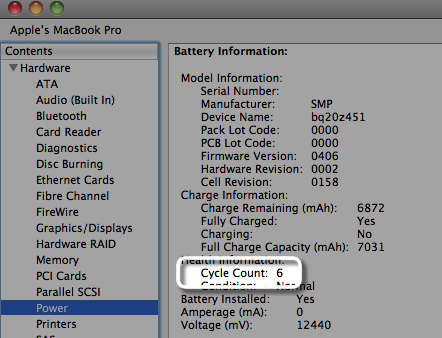Apple MacBook's battery: the right way, and the wrong way to charge it.
Just like on any other laptop, the battery life on a brand new Mac, typically matches Apple’s claims fairly accurately, only to degrade, slightly, over time, as the battery wears out.
For instance, the daily battery life on a 13 inch 2015 MacBook Pro lasts for up to 10 hours of web browsing, and 12 hours when watching movies from iTunes. On a 15 inch MacBook, a 9 hour span is what should be expected for the same activities.
Every time a MacBook is charged, from a drained battery to full, a “charging cycle” is complete, and every MacBook battery has only so many charging cycles available before it’s ready to be replaced.
Determining how many cycles a battery has left on a Mac is a fairly easy task. Simply click on the Apple menu, and choose System Information. Under the Hardware tree menu, select Power.
The available cycle count for the current battery will be available under Health Information.

Understanding cycle count
As previously mentioned, every complete charging cycle equates to one notch closer to the battery losing its ability to retain a charge. With that said, most consumers have very irregular charging patterns. Sometimes a cycle count is spread over a couple of days, especially when traveling for periods of time in which no power outlets are available.
In other scenarios, there are users who keep their MacBooks constantly plugged in, for instance, when working in an office for extended periods of time. This behavior is typical of consumers using laptops as “desktop replacements”, which is very common in production environments.
While overcharging may or may not have unusually negative effects on the battery, it’s debatable, but one true fact is that keeping a fully charged MacBook plugged in, while not inherently dangerous, it’s not a terribly efficient practice either.
This is because the practice of constantly charging a MacBook, or any other laptop, while in use, causes to eat through charging cycles faster, causing the overall battery life to wear out sooner.
The right way to charge a MacBook
It’s very typical for a MacBook’s battery to last quite a few years, and through several newer iterations of the same model, depending on the way the device is charged, day in, and day out.
The ideal way to charge a MacBook, which also applies to most laptops and portable devices, including tablets and phones, is to have short, scattered charging sessions throughout the day, without necessarily reaching a full charge. This allows to keep the MacBook operational, with sufficient charge for most tasks, without performing complete daily cycles, and especially, without consuming more power than required by a typical daily usage.
Charging your MacBook at night
While it’s perfectly safe to keep a MacBook charged overnight, it should be noted that battery efficiency will increase, when charging a MacBook that is completely powered down.